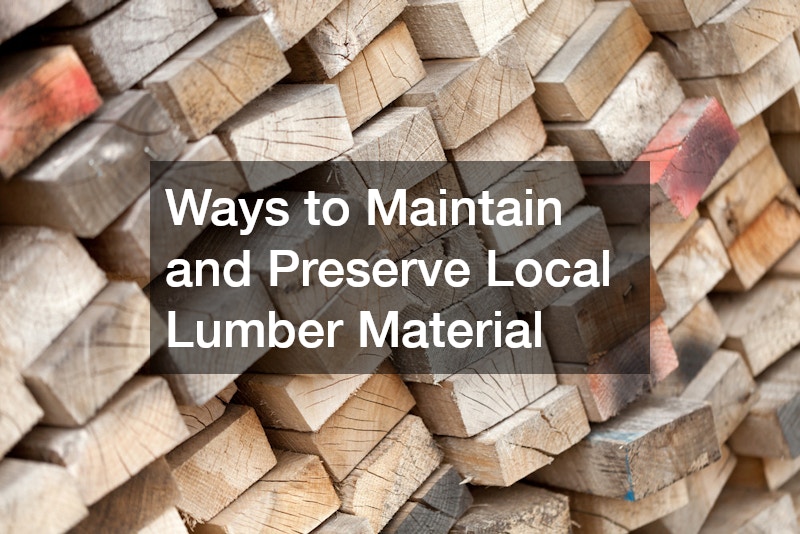
This article explores various ways to maintain and preserve local lumber materials, emphasizing their importance not only for sustainability but also for the economy and the broader environment. Proper care of lumber ensures that it lasts longer, performs better in construction projects, and reduces the need for frequent replacements, which in turn conserves natural resources. We will address common questions regarding the best practices for keeping lumber in optimal condition, including storage techniques, treatment methods, and protection from environmental factors such as moisture, pests, and temperature changes.
By following these guidelines, builders, hobbyists, and homeowners alike can make the most of their local lumber materials while contributing to responsible and eco-conscious building practices.
What Are the Best Practices for Storing Lumber?
Proper storage is essential for maintaining the integrity of local lumber. Incorrect storage methods can lead to warping, cracking, and other forms of damage. In order to avoid such issues, it is crucial to store lumber in a manner that minimizes exposure to the elements and physical stress.
One of the key aspects of lumber storage is keeping it off the ground. Elevating lumber on a flat surface prevents moisture absorption from the soil, which can lead to rot and mold growth. Using a good quality pallet or wood stackers can help maintain airflow around the lumber, further ensuring its longevity.
Additionally, it’s important to store lumber in a dry, climate-controlled environment, shielded from direct sunlight and extreme temperatures. Exposure to sunlight can cause discoloration and drying out of the wood, while drastic temperature changes can lead to expansion and contraction. Striving for stability in the storage environment ultimately helps to preserve the quality of local lumber materials.
How Can You Protect Lumber from Pests and Decay?
Pests and decay can significantly affect the durability of lumber. Without proper protection, infestations and fungal growth can compromise the structural integrity of wood, leading to costly replacements or repairs. Recognizing the threats is the first step in ensuring that protection measures are effective.
There are several treatment options available to help protect lumber from pests. Borate treatments are a popular choice, as they act as both a pesticide and a fungicide, preventing wood from being attacked by insects and fungi. Regularly inspecting lumber for signs of infestation is vital, allowing for early detection and intervention before significant damage occurs.
In addition to treatments, preventive measures like using physical barriers can provide extra protection. Sealants and protective coatings can create a barrier against moisture and pests, while ensuring proper ventilation can deter environments conducive to decay. Understanding how to employ both treatments and preventive measures will not only preserve the wood but also extend its lifespan significantly.
What Maintenance Practices Are Necessary for Preserving Wood?
Regular maintenance is key to prolonging the life of lumber materials. Without a proper maintenance regimen, even the highest quality lumber can suffer from wear and degradation over time. A proactive approach toward maintenance can save time and resources in the long run.
Essential maintenance routines include regular cleaning to remove dirt, dust, and debris that may accumulate on the surface of the wood. This not only enhances the appearance but also prevents grime from settling into the wood fibers, which can lead to deeper stains and potential decay. Sealing the wood with an appropriate product will also help repel moisture and shield against environmental factors.
Finally, conducting periodic inspections is crucial for assessing the condition of lumber. Look for any signs of wear, such as cracks, warping, or pest infestations. Addressing these issues promptly can help maintain the structural integrity of local lumber materials for many years to come, ensuring their continued use in sustainable building practices.
What Is the Impact of Weather on Local Lumber and How Can It Be Mitigated?
Weather conditions can play a significant role in the deterioration of lumber. Exposure to rain, snow, or extreme heat can cause wood to swell, crack, or undergo other irreversible changes. Understanding these impacts can guide proper storage and maintenance approaches.
For instance, prolonged exposure to moisture can lead to rot and mold, significantly weakening the wood. Utilizing sealants can provide that necessary layer of protection, preventing excessive moisture from penetrating the wood. Additionally, using UV-resistant finishes can protect against sun damage resulting from constant exposure to sunlight.
Implementing measures that account for local climate conditions is also wise. Regions prone to extreme weather conditions may require specific storage solutions, such as covered outdoor sheds or indoor climate-controlled spaces. Recognizing local weather patterns allows for more effective preservation strategies, ultimately aiding in the sustainable use of local lumber.
Maintaining and preserving local lumber materials requires awareness and action from both individuals and communities. By following the practices outlined in this article, we can ensure the longevity and sustainability of our valuable wood resources. Understanding proper storage, pest protection, maintenance, and weather mitigation can lead to more resilient and environmentally conscious usage of lumber.





